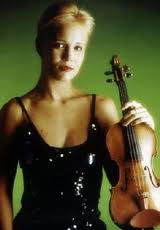This proved to be a fascinating evening of post-romantic music, which opened with Sibelius’ Pohjola’s Daughter. The sudden changes of mood and texture were very well captured and the moments of airy lightness particularly impressive. Although Sibelius draws on a very large orchestra, his writing is frequently thin and almost intangible. When power was needed, Sakari Oramo found this, particularly in the brass explosions, without any lack of clarity of texture. The final bars, a hushed whisper from low strings, were exquisite.
Leila Josefowicz was giving the UK premiere of Esa-Pekka Salonen’s violin concerto, and was doing so from memory. The work makes exceptional demands on the soloist, who is required to play extended passages at a furious tempo. It opens, however, with the solo violin accompanied only by remote percussion for Mirage. As the movement develops there are strong hints of gypsy and folk melodies lurking within the melos created, and these continue throughout.
The second movement Pulse I is more reflective, with long held chords and an extended section for violin and trumpet, which is effective and haunting.
Pulse II brings a frenzy of broken rhythms with strong jazz overtones. The percussion section, widely used in earlier movements though always discretely, now comes into its own and is joined by a drum kit. The soloist is here able to enjoy one of a few brief breaks as the orchestra launches into an extended dance-like section.
The final Adieu brings a long solo passage and an extended sense of melancholy, circling around an equally expressive cor anglais solo. When the orchestra joins them it is with deep-throated passion led by the percussion. After quiet meandering, the movement builds to the point where is overpowers the soloist before returning to a more dignified conclusion. This is a work which, while requiring large orchestral forces, could easily join the main repertoire.
After the interval we heard Shostakovich’s 5th Symphony. The opening Moderato balanced passion with any icy edge, particularly in the strings. There was a level of inherent violence throughout which threw the passage for flute and horn into stark relief.
The Allegretto had strong Mahlerian overtones but we quickly realised this is Shostakovich with a Mahler pullover. The tensions were strongly felt throughout, and were maintained into the Largo. Here Sakari Oramo created a sense of emptiness and desolation, a loss which cannot be reconciled. It was deeply moving and one was able to sense something of what touched the original audience. The final Allegro non troppo was exultant, almost hysterical, rather than joyous, catching the dichotomy of the writing and its original context.
Since taking over as Chief Conductor Sakari Oramo has re-focussed the orchestra and its playing of these late romantic works is exemplary.

